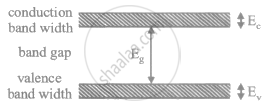Advertisements
Advertisements
प्रश्न
In a transistor,
पर्याय
the emitter has the least concentration of impurity
the collector has the least concentration of impurity
the base has the least concentration of impurity
all the three regions have equal concentrations of impurity.
उत्तर
the base has the least concentration of impurity
When the emitter of a transistor is forward biassed, the majority carriers move from the emitter to the collector through the base. As the base is thin and lightly doped, only small amount of a combination of electrons and holes takes place, leading to weak base current. This makes the collector current equal to the emitter current.
If we make any other choice for least concentration of impurity, we will have a low value of collector current. Thus, the purpose of a transistor will not be fulfilled.
APPEARS IN
संबंधित प्रश्न
Draw separate energy band diagram for conductors, semiconductors and insulators and
label each of them.
The conduction band of a solid is partially filled at 0 K. Will it be a conductor, a semiconductor or an insulator?
When an impurity is doped into an intrinsic semiconductor, the conductivity of the semiconductor
A semiconductor is doped with a donor impurity.
Indium antimonide has a band gap of 0.23 eV between the valence and the conduction band. Find the temperature at which kT equals the band gap.
Suppose the energy liberated in the recombination of a hole-electron pair is converted into electromagnetic radiation. If the maximum wavelength emitted is 820 nm, what is the band gap?
(Use Planck constant h = 4.14 × 10-15 eV-s, Boltzmann constant k = 8·62 × 10-5 eV/K.)
The conductivity of a pure semiconductor is roughly proportional to T3/2 e−ΔE/2kT where ΔE is the band gap. The band gap for germanium is 0.74 eV at 4 K and 0.67 eV at 300 K. By what factor does the conductivity of pure germanium increase as the temperature is raised from 4 K to 300 K?
The conductivity of an intrinsic semiconductor depends on temperature as σ = σ0e−ΔE/2kT, where σ0 is a constant. Find the temperature at which the conductivity of an intrinsic germanium semiconductor will be double of its value at T = 300 K. Assume that the gap for germanium is 0.650 eV and remains constant as the temperature is increased.
(Use Planck constant h = 4.14 × 10-15 eV-s, Boltzmann constant k = 8·62 × 10-5 eV/K.)
A semiconducting material has a band gap of 1 eV. Acceptor impurities are doped into it which create acceptor levels 1 meV above the valence band. Assume that the transition from one energy level to the other is almost forbidden if kT is less than 1/50 of the energy gap. Also if kT is more than twice the gap, the upper levels have maximum population. The temperature of the semiconductor is increased from 0 K. The concentration of the holes increases with temperature and after a certain temperature it becomes approximately constant. As the temperature is further increased, the hole concentration again starts increasing at a certain temperature. Find the order of the temperature range in which the hole concentration remains approximately constant.
(Use Planck constant h = 4.14 × 10-15 eV-s, Boltzmann constant k = 8·62 × 10-5 eV/K.)
If the lattice constant of this semiconductor is decreased, then which of the following is correct?

For germanium crystal, the forbidden gas energy gap
In a common-base circuit calculate the change in the base current if that in the emitter current is αmA and a = 0.98
In a semiconductor, the forbidden energy gap between the valence, band and the conduction band is of the order of
In a common base configuration Ie = 1 mA α = 0.95 the value of base current is
Hole are majority charge carrier in
Draw the energy band diagrams for conductors, semiconductors and insulators. Which band determines the electrical conductivity of a solid? How is the electrical conductivity of a semiconductor affected with rise in its temperature? Explain.
- Assertion (A): In insulators, the forbidden gap is very large.
- Reason (R): The valence electrons in an atom of an insulator are very tightly bound to the nucleus.
With reference to semiconductor physics, answer the following question.
In which material “Forbidden band” is absent?
